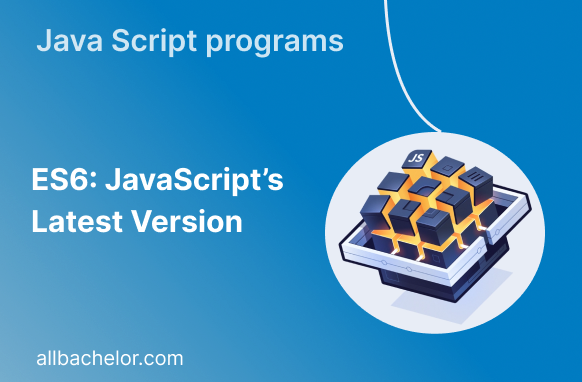If you’re new to JavaScript, you might have heard people mention “ES6.” It stands for ECMAScript 6, which is the sixth version of a set of rules called ECMAScript that defines how JavaScript works. It was released in 2015 and brought a lot of new features and improvements to JavaScript. In this beginner-friendly blog post, we’ll explore some of these features and see how they can make JavaScript development easier for you.
Let’s begin our journey into ES6 and discover how it can enhance your JavaScript skills!
What is JavaScript ES6, and how does it differ from previous versions?
JavaScript ES6, also known as ECMAScript 6, is the sixth edition of the JavaScript standard. It brought many new features and improvements to the language, making it more powerful and expressive. Let’s explore some of these features in a way that’s easy to understand:
- Arrow functions: A shorter and simpler way to write functions.
- Block-scoped variables: “let” and “const,” for declaring variables.
- Template literals: An easier way to work with strings.
- Destructuring assignments: Easier to extract values from arrays and objects.
- Classes: A new syntax for creating classes in JavaScript.
How can I use arrow functions in ES6, and what benefits do they offer?
Arrow functions are a simpler way to write functions in ES6. Let me provide you with an example of an arrow function that adds two numbers:
Arrow functions offer a few advantages:
- Shorter syntax: They remove the need for the `function` keyword and curly braces in certain cases.
- Lexical `this`: Arrow functions do not bind their own `this` value, which can help prevent confusion in certain situations.
- Implicit return: If the function body consists of a single expression, it will be automatically returned without requiring the `return` keyword.
What is the purpose of let and const in ES6, and how do they differ from var?
In ES6 (ECMAScript 2015), two new ways to declare variables were introduced: `let` and `const`. They are alternatives to the older `var` keyword. Here’s how they differ:
- `let`: Variables declared with `let` have a limited scope. This means they can only be accessed within the specific block of code where they are defined. For example, inside a loop or an if statement. This is helpful because it prevents issues with variable hoisting (when variables are moved to the top of their scope) and unintended global scope (where variables are accessible from anywhere in the code).
- `const`: Constants declared with the `const` keyword are like variables declared with `let`, but there’s one important difference. Once you set a value to a constant, you can’t change it later. In other words, it stays the same throughout your code. Constants are useful when you have values that should never change while your program is running.
Using `let` and `const` instead of `var` is beneficial for beginners as it helps in writing code that is easier to understand, maintain, and predict. Unlike `var`, `let` and `const` offer more control over variable behavior, scope, and immutability, which can prevent unexpected issues in your code. By using `let`, you can declare variables that can be reassigned, while `const` allows you to declare variables that should remain constant. This makes it easier to manage and track changes to your variables, leading to more reliable and organized code.
How do ES6 template literals improve string handling in JavaScript?
ES6 brought a helpful feature called default function parameters. This feature lets you set default values for the parameters of a function. These default values are used when no argument is given or when the argument is intentionally set as undefined. Here’s an example
In the greet function, the parameter called “name” has a default value of ‘friend’. When you call the greet function without passing any argument for the name, it will automatically use the default value. However, if you do provide an argument for the name, it will override the default value and use the provided value instead.
Default function parameters are helpful because they make functions more adaptable and self-contained. They allow you to set sensible default values, which reduces the need for extra conditional checks in your code.
What is the significance of the spread operator in ES6, and how can it be used?
The spread operator (represented by “…”) is a helpful feature introduced in ES6 (a version of JavaScript). It does something cool: it allows you to take the elements of a group (like an array or a string) and use them as separate pieces. It’s like unpacking a box and using each item inside individually. This can be really useful when you want to work with each element separately instead of treating them as a whole group. Here are a few use cases:
Array manipulation:
The spread operator can be used to concatenate arrays or add elements to an existing array easily.
Function arguments:
The spread operator allows you to pass individual elements of an array as arguments to a function, which can be helpful when working with variable-length argument lists.
Object manipulation
The spread operator can merge the properties of multiple objects into a new object.
The spread operator is a flexible tool that makes many common programming tasks easier and provides a shorter way to write code.
How does ES6 enhance object-oriented programming with the introduction of classes?
ES6 brought a new way of creating classes in JavaScript, which follows a more familiar and organized approach to object-oriented programming. This new syntax makes it easier to work with classes and brings a clearer structure to your code. Here’s an example:
In this example, we have an Animal class that has a constructor (a special method for initializing objects) and a speak method (to make the animal “speak”). We also have a Dog class that extends (inherits from) the Animal class and changes the behavior of the speak method for dogs.
By using classes in ES6, we can define objects and their behavior in a more organized and structured manner. This helps us better organize our code and handle inheritance (when one class inherits properties and methods from another). We can create instances (individual objects) of these classes and call their methods to perform specific actions.
What are modules in ES6, and how can they be used to organize and structure code?
ES6 modules are a way to organize our JavaScript code. Think of them as separate compartments that hold different parts of our code, like rooms in a house. Each module has its own private variables, functions, and classes, which can only be accessed from within that module. However, we can choose to export certain things from a module, making them available for other modules to use. It’s like sharing a key to a room with someone else. By importing these exported items, we can use them in our own code. ES6 modules help us keep our code organized, reusable, and easier to understand, especially as our projects become more complex. Here’s an example:
In this example, we define two functions in the math.js module and export them using the export keyword. In the main.js module, we import those functions using the import keyword and use them in our code.
Modules help encapsulate code, promote code reusability, and provide a clear structure for organizing dependencies. They are widely used in modern JavaScript development.
How does ES6 introduce Promises for handling asynchronous operations?
ES6 brought in a new feature called Promises that makes it easier to deal with tasks that take time to finish in JavaScript. Think of a Promise as a representation of something that will eventually be done, like fetching data from a server or performing a time-consuming task. With Promises, you can connect these tasks together in a sequence using “then” and “catch” methods, which help you handle the successful completion or failure of the tasks. Here’s an example:
In this example, the fetchData function returns a Promise. Within the Promise constructor, we simulate an asynchronous operation using setTimeout. If the operation is successful, we call resolve with the data. If there’s an error, we call reject with an error object.
By chaining then and catch methods, we can handle the resolved value or the rejected error accordingly. Promises provide a more structured and readable way to handle asynchronous operations compared to traditional callbacks.
What are some useful built-in methods introduced in ES6 for manipulating arrays and objects?
ES6 introduced some helpful built-in methods that make working with arrays and objects more convenient. Let’s take a look at a few examples:
Array methods:
- map: This method creates a new array by applying a function to each element of the original array. It allows you to transform the elements based on your requirements.
- filter: With filter, you can create a new array that contains only the elements satisfying a condition specified in a function. It helps you easily extract the desired elements from an array.
- find: The find method returns the first element in an array that satisfies a given condition specified in a function. It’s useful when you want to locate a specific element based on a condition.
- reduce: reduce is used to apply a function to each element of the array, in order to reduce the array to a single value. It can be utilized for tasks like summing up all the elements or finding the maximum value.
Object methods:
- Object.keys: This method returns an array containing the own enumerable property names (keys) of a given object. It helps you extract the keys to iterate or perform further operations on them.
- Object.values: With Object.values, you can obtain an array of the own enumerable property values of an object. It’s useful when you need to extract the values for processing or displaying purposes.
- Object.entries: The Object.entries method returns an array of arrays, where each inner array contains a key-value pair from the given object. It provides an easy way to iterate through the key-value pairs.
These special methods that are built into JavaScript make it easier to manipulate arrays and objects in your code. They simplify common tasks related to arrays and objects, making your code shorter and easier to understand. By using these methods, you can express your intentions more clearly and efficiently when working with arrays and objects in JavaScript.
How can ES6 generators be used to create iterable sequences?
Generators are a special type of function introduced in ES6. They are created using the function* syntax. Generators have the ability to produce iterable sequences, which means they can generate a series of values. They use the yield keyword to pause the execution of the function and return a value. This allows you to generate multiple values over time instead of returning a single value like regular functions. Here’s an example:
In this example, the generateSequence generator function returns an iterator. When we call next() on the iterator, it executes the function until it encounters a yield statement, returning the yielded value. Each subsequent call to next() resumes the function execution until the next yield statement.
Generators are useful for creating custom iterable objects and implementing lazy evaluation of sequences, among other things.
What is the purpose of the import and export statements in ES6 modules?
The import and export statements in ES6 are used to bring in and share functionality between different modules. They enable you to break down your code into smaller, reusable modules, and define which parts of a module should be accessible to other modules.
- export is used to define what parts of a module should be exported and accessible to other modules. You can export functions, variables, or even classes.
- import is used to import functionality from other modules. You can selectively import specific functions, variables, or the entire module.
The import and export statements help modularize your codebase, improve code organization, and promote reusability.
How can I transpile ES6 code to be compatible with older browsers using tools like Babel?
In order to ensure compatibility with older browsers that may not support all ES6 features, you can utilize tools like Babel to transpile your ES6 code to ES5. Transpilation refers to the process of converting code from one version of JavaScript (ES6) to another (ES5). This allows your code to be understood and executed by older browsers that may not have native support for the latest JavaScript syntax and features.
Here are the general steps to transpile ES6 code:
- Set up a build system: Use tools like Webpack, Rollup, or Gulp to automate the build process.
- Install Babel: Install Babel and the necessary plugins and presets for transpiling ES6 code.
- Configure Babel: Create a .babelrc file or configure Babel in your build tool’s configuration file. Specify the plugins and presets you want to use.
- Transpile the code: Run your build system or use the Babel CLI to transpile your ES6 code. The output will be ES5 code that is compatible with older browsers.
By transpiling your code, you can leverage the latest JavaScript features while ensuring broad browser compatibility.
In conclusion, ES6 brought many great improvements to JavaScript development. It added helpful features like arrow functions, block-scoped variables, classes, modules, and Promises. These additions made the language more powerful, and easier to understand and allowed for cleaner code. Even if you’re new to programming, learning and using these features will make your JavaScript code more efficient and modern.



